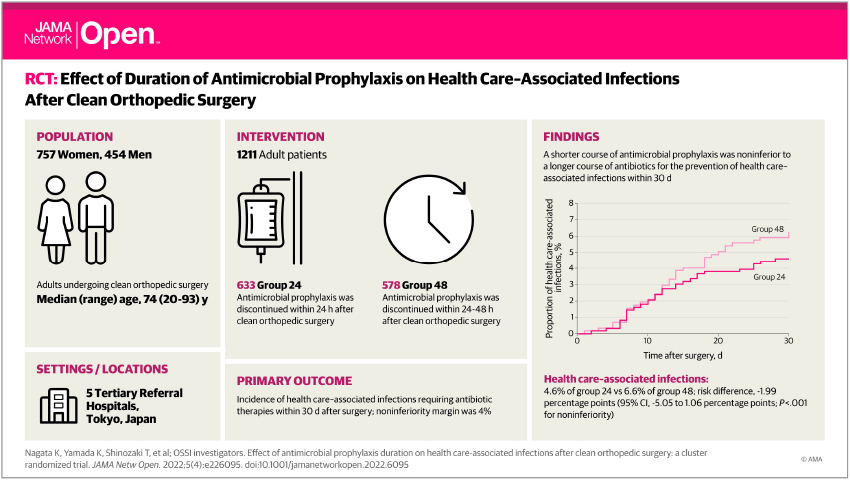1211 participants underwent “clean” (a CDC definition of infectious nature of the surgery) orthopedic surgery, were given appropriate antibiotics within an hour of beginning surgery, and repeated every 3 to 4 hours during surgery. Additionally, as orthopedists often do, the surgical site was covered with an antiseptic plastic film. The surgical wounds were washed out with antibiotic solutions, and antibiotic-coated sutures were used.

About 40 to 50 patients in each group did not get the “benefit” of the plastic film, sutures, or antibiotic rinse, and they were eliminated from the study.
- Some participants received post-operative antibiotics for the next 24 hours, the rest for 48 hours.
- Those receiving only 24 hours of antibiotics had fewer infections by about 2% than those receiving antibiotics for 48 hrs.
- This was the case for infections at the surgical site, urine, and the lungs. Two of the participants in the 48-hour group died from aspiration pneumonia (where GI contents are inhaled into the lung, creating a chemical inflammation and then that is secondarily infected)
- The use of antibiotics for only 24 hours post-operatively was no better or worse( termed non-inferior) than extending their use an additional 24 hours.
Who cares?
The financial cost of a second 24 hours of antibiotics is chump change, especially when compared to the cost of an infectious complication that results in prolonged hospitalization or readmission. Just one of those events would easily cover the cost of hundreds of patients getting an additional day of antibiotics.
But the real reason is that prolonging the use of antibiotics results in increasing antimicrobial resistance, which in turn results in more infections that, in turn, require more expensive medications and hospitalizations. The Goldilock’s length of antibiotic treatment, not too long and not too short, is unknown. We used to think longer is better, e.g., 72 hours, but studies have moved the goalposts to 48. In fact, at this juncture, the CDC recommends no post-operative antibiotics for clean orthopedic surgery. The orthopedists are not ready for that, but maybe 24 hours could be the new compromise.
Source: Effect of Antimicrobial Prophylaxis Duration on Health Care–Associated Infections After Clean Orthopedic Surgery A Cluster Randomized Trial JAMA Network Open DOI: 10.1001/jamanetworkopen.2022.6095




